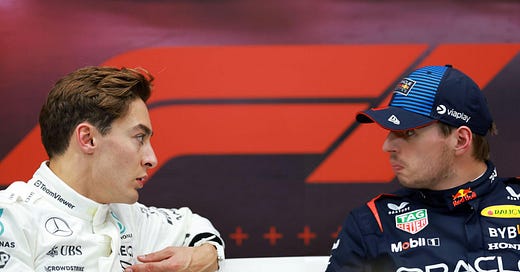Welcome to The Undercut, a weekly newsletter round-up of the top storylines in racing brought to you by your favorite motorsport and enviro journo, Olivia Hicks. If you’re wondering “What the f*** is Formula 1?” Ask away! Leave a comment or send me a message with your burning questions.
One Point From a Race Ban, Verstappen Teeters on the Edge of Track Ethics
The elephant in the paddock and news cycle is Max Verstappen. Arguably, he has been since he joined the sport as a fresh-faced 17-year-old in 2015.
But on Sunday, the 27-year-old Dutch driver reminded everyone who he is and how he races. With just six laps to go in the Spanish Grand Prix, Verstappen, who had left the track during a tussle with George Russell, briefly allowed the British driver to regain his place before crashing into the Mercedes. Verstappen dropped from third to 10th after the illegal move.
The headlines that followed carried a string of similar words, most arguing that Verstappen is at risk of ruining his legacy. Sky Sports reporter Rachel Brookes asked him post-race if the move was intentional and Verstappen responded with his own question: “Does it matter?”
“You pull off something like the move in Imola and we all see what an incredible driver you are and it’s horrible to see that shine taken off,” Brookes said.
Most opinion pieces that followed Sunday’s race argued that the sport’s ruling body has failed to punish Verstappen for his on-track behavior, encouraging him to bend racing’s ethical code repeatedly. Russell’s comments hinged upon the fact that children are at home watching and Brookes argued that his dirty moves taint his image “for fans and for kids watching.”
Verstappen’s fans claimed that, whether ethical or not, his performance was entertaining. Verstappen won the “Driver of the Day” award.
Nicknamed “Mad Max” and “The Inevitable,” Red Bull’s star driver has been placed under a microscope with his actions, whether good or bad, amplified. Now, he faces the possibility of a race ban.
In October, I wrote a piece based on similar circumstances following the Mexico City Grand Prix where Verstappen’s racing against Lando Norris awarded him a 20-second penalty. Norris’ radio message, “This guy is dangerous,” summed up the Red Bull driver’s long-standing reputation as an on-track terror.
From October’s piece “This Guy is Dangerous:”
Perhaps Verstappen’s greatest tool is the psychological effect he seems to have on his rival racers. The rhetoric in 2023 was that he was unbeatable, with few drivers putting up an actual fight to defend against his RB19 — more rocketship than car.
And that’s also possibly the issue with Verstappen as a character in Formula 1: this idea that everything he does is imminent. If Charles Leclerc is Ferrari’s “Il Predestinato,” the predestined son who will carry on a legacy of prestige and self-sacrifice, Verstappen is the fated villain. As Fernando Alonso said, in the sport you’re either a hero or an anti-hero.
But for Verstappen sympathizers and haters, his identity swings between victim and villain depending on who you ask. Branded as brash and brazen — a near-identical fit for the energy drink company adorning his coveralls — Verstappen’s actions are treated by both his supporters and dissenters as a certainty, a birthright.
While portraying the 27-year-old as a victim, fans stitch together clips of a six-year-old Verstappen ensconced within a go-kart with a melancholic piano plucking in the background. News stories about his strict upbringing paint him as a misunderstood boy-turned-man who inherited his former Formula 1 driver father’s appetite for aggressive driving.
And those who see a villain treat his reign and tactics to reach the top as nothing less than inevitable. Drivers swerve and brake to avoid the, also inevitable, collision that comes with racing Verstappen. “Max is kind of do-or-die,” Hamilton said in 2022. “It’s like you’re either crashing or you’re not going by.”
Even Formula 1 outsiders have portrayed him as someone with little free will: in a controversial Road & Track article, taken down quickly after it was published, Verstappen was called a foil, “one who reveals more about the characteristics of other people than a well-built character in his own right.”
After 10 years in the sport, Verstappen’s ability to do the unthinkable — both in racing achievements and in bending ethics — has solidified him in the history books. Whether his fits of frustration will taint his legacy or not, he embodies a character every sport needs — forcing those who write the rules to draw contours around them. In a sport that was founded on operating in the gray areas, in many ways Verstappen is the perfect personification of motorsport’s best and worst qualities. While Formula 1 increasingly becomes more show business than sporting event, he prompts the question, “Is this good racing or just good TV?”
Every narrative arch needs a villain. As the four-time world champion teeters on the brink of a one-race ban, spectators are forced to imagine the sport without one of its main characters.
What I’ve been writing this week
Monaco F1 GP Date Stepping Out of Indy 500’s Shadow Just Might Save It - The Drive, Olivia Hicks
I Went to Sports Romance Con - Formula Flash, Olivia Hicks








